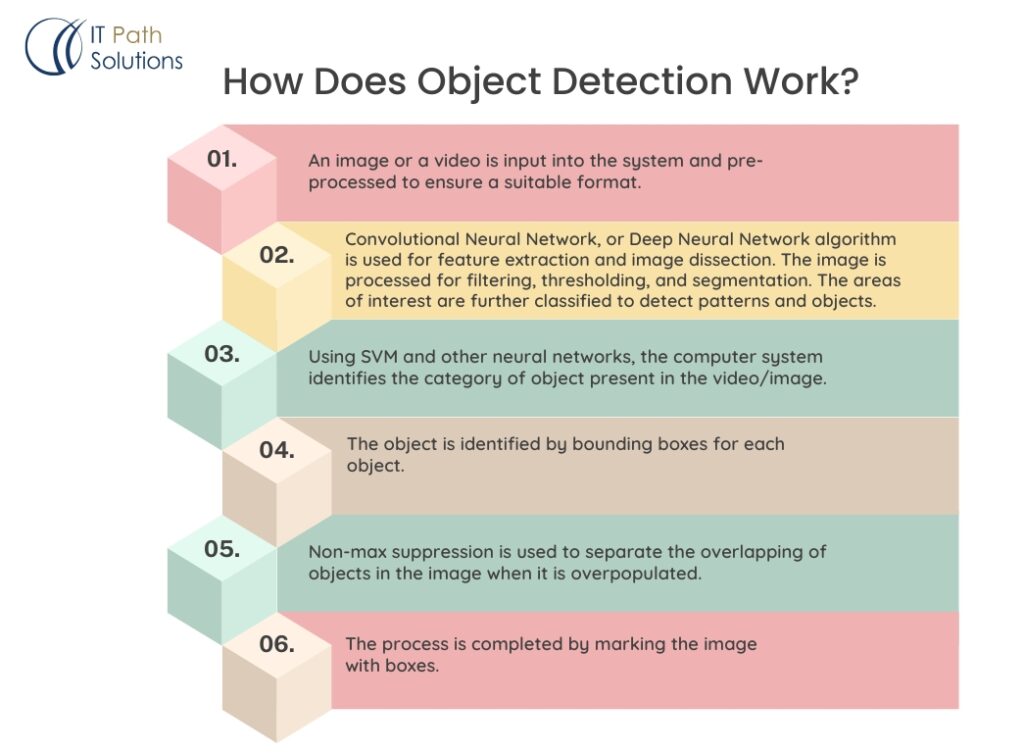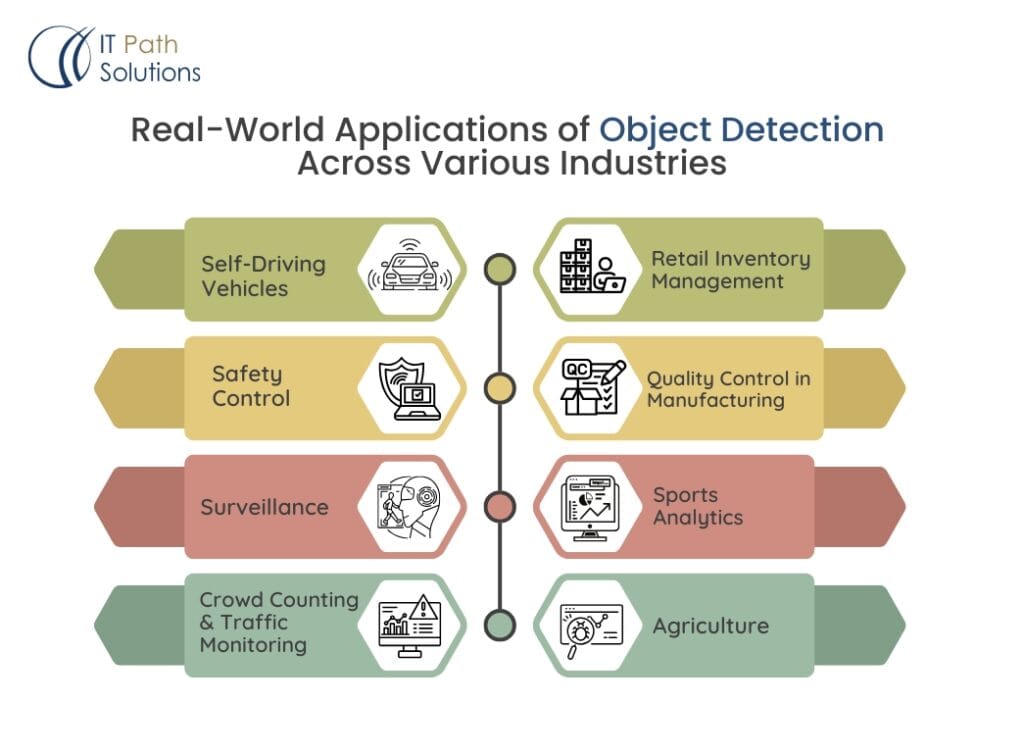Object Detection in Computer Vision: Techniques, Algorithms & Applications
Keyur Patel
September 12, 2025
7 min
Object detection is a computer vision technique that facilitates systems to identify and locate objects in images and videos. With recent advancements in Artificial intelligence and computer vision domains, object detection has become excessively useful and relevant across various applications.
Can you imagine machines and software trained to distinguish a specific white car from a pool of vehicles lying in the parking lot? Or even detect a single toothpaste tube being removed from the shelf in a retail store? The possibilities of object detection applications are endless. Do you agree?
In this blog, we will go through every single detail of object detection and understand how different businesses can use this technology.
To begin with,
What is Object Detection?
Object detection is a well-structured computer vision technique that is used particularly for identifying, locating, and categorizing objects in digital and video images. It follows an applied intelligence approach, where engineers train the computers to interpret visual data just like humans. Today, modern object detection systems are trained to understand the characteristics of objects in the surroundings.
The object detection process aims to answer two critical questions about any image in question,
- What is the category of objects present? Example: Is it a car, motorcycle, bike, or bus?
- Where are these objects located? Example: identifying and marking the position of an object in the image or motion video.
The above information helps in narrowing down the list of key components of object detection:
Image classification:
Image classification is the process of analyzing visual data and extracting information from the image. On the basis of this analysis, the object is classified and assigned a label within the image.
Object localization:
Object localization is the process of identifying the object’s position within the image. Once it is positioned, the object is highlighted with a box or circle around it.
Object detection:
Object detection combines both classification and localization.
How Does Object Detection Work?
The normal process of object detection is as follows:

An image or a video is input into the system and pre-processed to ensure a suitable format.
↓
Feature extraction and image dissection are performed using a Convolutional Neural Network, or Deep Neural Network algorithm. This image is processed for filtering, thresholding, and segmentation. The areas of interest are further classified to detect patterns and objects.
↓
By using SVM and other neural networks, the computer system identifies the category of object present in the video/image.
↓
The object is identified by bounding boxes for each object.
↓
Non-max suppression is used to separate the overlapping of objects in the image when it is overpopulated.
↓
The process is completed by marking the image with boxes.
Object detection uses machine learning algorithms and neural networks to process the vast amount of data collected. The analyzed data is further used for training the systems to identify and classify images respectively.
Object detection enables computers to observe reality, just like human beings. Because of this capability, object detection is widely used in the automobile industry, healthcare, manufacturing industry, surveillance, and robotics.
What Are The Most Popular Object Detection Algorithms?
Convolutional Neural Networks are widely used for object detection due to their commendable feature extraction capabilities. Here is a list of popular CNN algorithms used for object detection.
Single Shot Detection (SSD):
SSD is a deep-learning-based object detection approach that performs object detection in a single pass using neural networks. It facilitates faster detection by identifying object locations and categories simultaneously.
Region-based Convolutional Neural Networks (R-CNN):
R-CNN initially generates region proposals using a selective search algorithm and then extracts features from the proposed region using CNN.
You Only Look Once (YOLO):
YOLO is known for its impressive speed and predicting bounding boxes capabilities. The fast prediction is extremely suitable for real-time applications.
Faster R-CNN:
It is based on the R-CNN approach that introduces a region proposal network that shares features with subsequent object detection networks.
What are the various object recognition techniques?
Object recognition algorithm uses different techniques to detect and recognize objects. The following are the commonly used techniques used for object recognition.
Template matching:
It is one of the most widely used techniques to compare and recognize characters, numbers, objects, patterns, and letters.
Color-based matching:
Color-based matching is a technique to distinguish colors which can further be used to classify objects or recognize objects with distinct color features.
Active and passive recognition:
Active and passive recognition deals with object identification in live images versus existing images respectively.
Shape-based recognition:
This method matches the shape of the object in an image or a video.
Real-World Applications of Object Detection Across Various Industries:
The following use cases of object detection confirm how these smart technologies have been embedded in our daily lives.

Self-driving Vehicles:
Self-driving cars are capable of seeing and analyzing road situations around them just like a human driver. Autonomous vehicles use an array of cameras, radars, and sensors to identify objects from a distance. The smart algorithms are capable of identifying not just vehicles, pedestrians, and bicycles but also assessing their size, speed, and trajectory of movements.
Are you ready to embrace your new navigation partner?
Safety control:
With the advent of object detection in computer vision, it will now be possible for the manufacturing or construction industry to enhance safety by identifying potential threats in a controlled area. The algorithms can be trained to identify objects with specific tags such as a person wearing a helmet, a person without a helmet, a person standing near a potential threat (distance-wise), a person standing away in a safe zone, and so on. This technology can help create safer work environments by enabling proactive threat detection.
Surveillance:
Object detection and AI in surveillance serve as a great tool for security teams. Smart object detection algorithms can be trained to identify harmful objects like knives, guns, etc, that violate the policy of a place.
These advanced cameras and sensors can potentially replace a team of security agents and are widely used in high-security areas such as government offices, financial institutions, malls, etc.
Crowd counting and traffic monitoring:
Object detection can be used to automate people counting in heavily populated areas, or measure pedestrian traffic inside and outside stores, or malls. Also, it can be used to monitor vehicles on routes helping manage traffic flow and improve transportation systems.
Retail Inventory management:
Retail stores will benefit the most from the implementation of object detection technology. Object detection when paired with AI and machine learning algorithms can help retain businesses gain insights into customer behavior, preferences, and checkouts. Using this analysis, businesses can optimize their store layouts accordingly.
Similarly, object detection can also be used to track inventory levels, observe product removal from shelves, and send alerts for restocking accordingly.
Not just that, object detection helps in notifying if any items are stolen or intentionally misplaced, helping retail stores enhance their security and reduce losses.
Quality control in manufacturing:
By using object detection and neural networks, the manufacturing industry can automate quality-checking processes. Neural networks quickly identify irregularities in shapes, minute defects, and other quality check parameters and thereby streamline the entire quality assurance process.
Also read :- Vision Inspection Systems in Manufacturing
Sports analytics:
Sports coaches and teams together can look into every inch of the game, from player movement, to ball trajectory using smart sensors, cameras, and object detection algorithms.
Think about how the third-umpire view in cricket helps in decision-making – it’s the same thing.
Agriculture:
Object detection is used in the agriculture industry to monitor the health of the plants, pest control, crop maintenance, and yield estimation.
How IT Path Solutions can help you?
IT Path Solutions expertise in delivering AI/ML Solutions powered by computer vision. We are one of the most trusted companies for developing object detection software and have successfully served across many industries.
We master the art of developing customized object detection solutions that cater to different business needs. If you want to avail our services, please get in touch with us.

Keyur Patel
Co-Founder
Keyur Patel is the director at IT Path Solutions, where he helps businesses develop scalable applications. With his extensive experience and visionary approach, he leads the team to create futuristic solutions. Keyur Patel has exceptional leadership skills and technical expertise in Node.js, .Net, React.js, AI/ML, and PHP frameworks. His dedication to driving digital transformation makes him an invaluable asset to the company.


